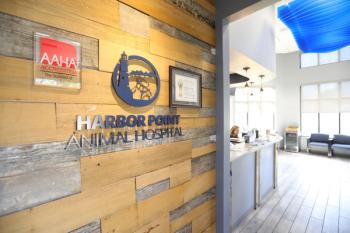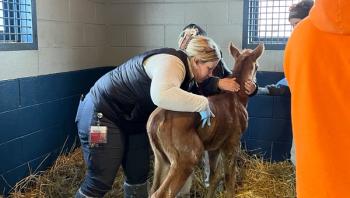
AAHA revamps hospital accreditation standards
Fast-food service mogul Ray Kroc once said the quality of a leader is reflected in the standards they set for themselves.
Fast-food service mogul Ray Kroc once said the quality of a leader is reflected in the standards they set for themselves.
The American Animal Hospital Association (AAHA), in its mission to mass-produceleaders of the veterinary profession, has taken to heart the McDonald'sfounder's credo.
In its most substantive undertaking in a decade, the association hastrashed, tweaked, rewritten and carved out its most comprehensive set ofaccreditation standards for companion animal practices to date.
"It's very substantial. It has probably the greatest opportunityto improve the quality of care of practices across the country - as greatan opportunity as anything that has ever been seen within the profession,"says Dr. Link Welborn, chair of the AAHA Standards Enhancement Taskforce,and owner of three companion animal practices in Tampa, Fla.
Raising the bar
AAHA's board of directors approved the revisions in November. The numberof standards will jump from roughly 300 to 1,200 when the revisions takeeffect this spring.
"There was a feeling among the leaders of the association that thetime had come to raise the bar for the standards within practices,"Welborn says.
One of those leaders, Dr. Steven Holmstrom, a taskforce consultant, saysthe standards position the profession at the proverbial fork in the road.
"We have a choice when practicing," says Holmstrom. "Throughour careers we can either practice 40 years of veterinary medicine or oneyear 40 times. That is, we can either progress in our skills and equipmentor we keep doing the same thing, year after year. These standards are away of ensuring that we continue to grow."
The association is the only veterinary organization to provide practiceaccreditation, what some consider the lifeblood of the organization.
About 40 specialists from varied disciplines nationwide provided inputfor the standards overhaul, which currently apply to companion animal practitionersonly. Updated standards relevant to specialty practice are slated to arrivein late 2003.
Nuts and bolts
The standards, according to AAHA, precisely measure how the profession,or at least accredited practices, should be held accountable in traditionalareas of practice, such as laboratory, pharmacy and medical records protocols,and previously unmeasured categories, such as pain management, ethics, contagiousdisease and leadership.
"For the first time, the profession will have access to a road mapto high quality medicine," says Dr. John Albers, executive directorof AAHA. "For many years the impression (of AAHA) has been - and it'snot unjustified - that our standards have focused more on facilities andequipment and procedures. These standards for the first time are reallyall about quality of care issues."
In reviewing ethics standards, for example, Welborn says the goal isnot for AAHA to take liberties to provide blanket ethical guides but toallow each practice to develop custom measures.
"While we would not decide whether these guidelines were right orwrong we would say, 'Yes, this practice has taken the time to give somethought about ethical questions that face the profession and has developedguidelines to address it within their practice,'" says Welborn, AAHApresident-elect.
Dr. Robert Lofton, another taskforce member and AAHA director, adds thatthe new standards consider the people behind the practice. "(The standards)will help us become better veterinarians, because they deal more with patientcare and quality of patient care and not so much with bricks and mortar-the building, facility, whether you have certain physical things withinyour hospital."
The new standards additionally incorporate methods outside veterinarymedicine. AAHA extensively perused standards of its human counterparts inthe Joint Commission for the Accreditation of Healthcare Organizations.Apparently, many of its standards now draw direct correlation to human medicine,according to taskforce members who declined to elaborate.
Give standards a chance
There's no question the new standards may at first appear daunting tounacquainted veterinarians.
"If I were going to be accredited for the very first time and realizedthe difference in the volume (of standards), at first it would take me back,"says Lofton, who has worked on previous accreditation standards. "Butonce you start to read the standards, you'd find they're very easy to complywith if the veterinarian is conducting quality medicine."
AAHA touts quality medicine, or quality of care, as the pinnacle towardwhich veterinarians should aspire. Quality of care by definition, accordingto Holmstrom, is "practicing the best medicine, surgery and dentistrypossible using state-of-the-art equipment and techniques."
Something old, something new
In the past, AAHA primarily intended to accredit AAHA-member practicesonly. Currently, 15 percent of all practices in the United States and Canadaare accredited.
Some changes and additions to the new standards:
* Accessible online. The association plans to post all standardson its Web site at www.aahanet.org, available to all members.
* Open to other associations. AAHA also intends to set up theWeb site such that members of other associations can gain access, includingthe American Veterinary Medical Association and the Canadian VeterinaryMedical Association.
"What we're talking about is allowing the standards to be distributedvery widely within the profession so that if practices are just curiousabout what the standards are like, then they can go to the Web site, viewthe standards, print them out and can view their practice and say, 'Yes,accreditation is something I would like to pursue,'" says Welborn.
He adds, "Even if they just look at the standards and say I'm notreally ready for accreditation just yet, but only pick out a few thingsand implement those changes in their practice, then we feel that we've madea difference in a lot of practices that we may not have touched in the past."
* New protocols within standards.
"For example, there's a new way to prep for surgery, i.e. an FDA-approvedsoapless, waterless means," says Dr. Dennis Feinberg, AAHA vice president-electand current member of the taskforce. "What we're doing is substantiatingthese types of things."
To paraphrase, the AAHA standard recommends that a practice use a protocolto ensure proper preparation of surgeons and surgical assistance.
"As soon as we have the word 'protocol,' "says Feinberg, "whatwe're doing for our members is creating a template."
They can create their own protocol, he adds.
* Point-based system. AAHA is eliminating the former tiered system,which classified and assessed practices in two-, three- or four-year cycles,according to the amount of effort the practice expended. By early 2003 allaccredited practices will be assessed every three years according to a newlyestablished point system. An assessment typically involves a practice consultantwho conducts a site visit and practice survey to ensure compliance.
"Every veterinarian I meet indicates that they practice high qualitymedicine," says Albers, who has reviewed the standards. "Thiswill provide them with an objective assessment of whether or not in factthey do."
With the point-based system, practices will not have to fulfill everystandard in the new accreditation program, which means all standards arenot mandatory. However, practices cannot opt out of an entire section.
Although the changes are hardly minor, Feinberg says there's no reasonfor premature fretting from veterinarians.
"We're hoping that by giving these resources, it's not, 'Oh, mygosh, in April I'm going to be evaluated.' It's that you're embracing it,because it allows you to feel good about what you're doing," he says.
The standards won't be finalized until AAHA completes beta testing ofnumerous practices to develop point totals for all sections as well as apass/fail level, according to Welborn, whose practice was first to undergotrial tests. Once editing and testing is completed, AAHA will market itsstandards online as well as via CD-ROMs that will be distributed to accreditedpractices and at its annual meeting in March.
Team effort
The taskforce has had little time to sleep in the last 16 months whilepreparing the final version of the standards.
"The standards represent an incredible amount of work on the partof the taskforce that put them together," says Albers. "I reallythink that the profession will benefit from them, whether they choose tobecome AAHA members, accredited members or not."
Adds Feinberg, "We're trying to make change within the organizationquicker than change outside the organization," says Feinberg. "There'sthat old saying, if the change outside the organization is moving at a quickerpace than change inside the organization, the end is near."
Newsletter
From exam room tips to practice management insights, get trusted veterinary news delivered straight to your inbox—subscribe to dvm360.






